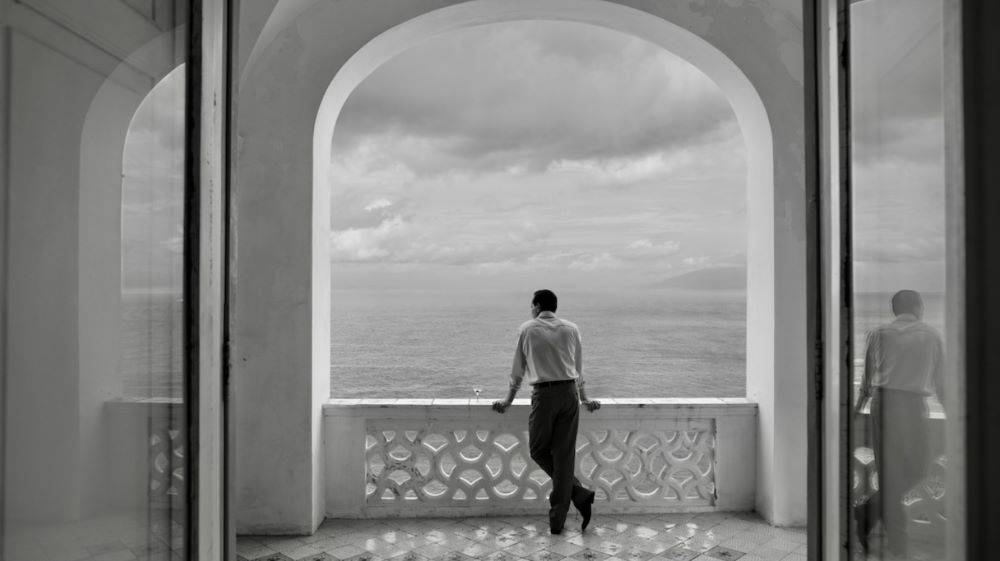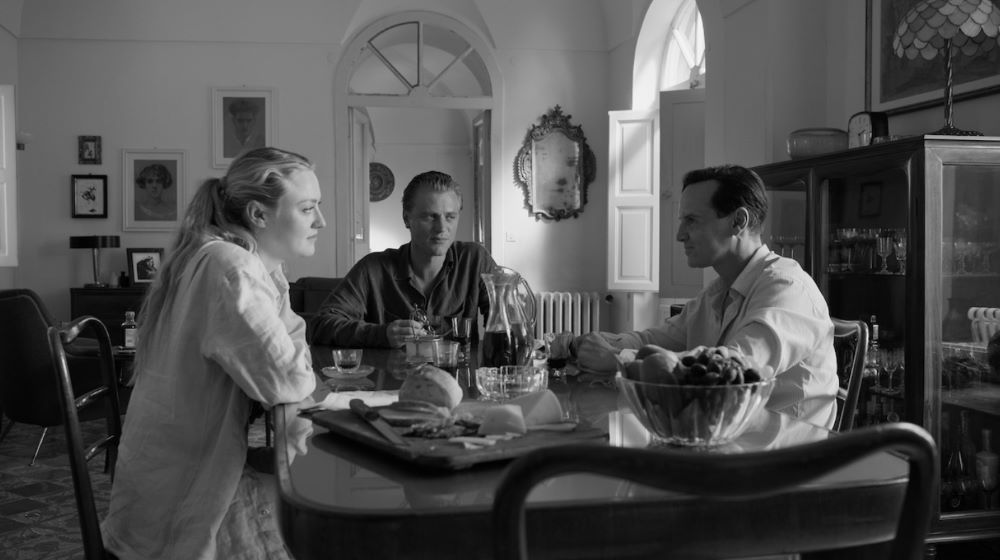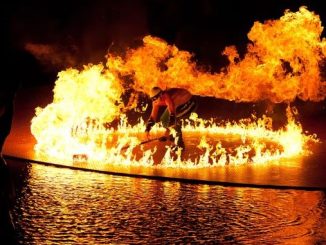At once the most beautiful and most horrifying eight hours of television you’ll see this year, Netflix’s Ripley, adapting for the umpteenth time Patricia Highsmith’s 1955 novel The Talented Mr. Ripley, is a marvellous showcase for actor Andrew Scott, the art of black-and-white cinematography, and the Amalfi Coast – and not necessarily in that order.
And while Ripley‘s – and Ripley’s – relentlessly bleak nature can be exhausting after a while – the highly bingeable series drops all eight episodes on April 4, 2024 – it’s a journey through familiar waters which is still well worth the plunge.

Produced by Showtime, Netflix’s Ripley is a basically faithful adaptation of Highsmith’s 1955 novel, here set in 1960 – not coincidentally, the year the first Ripley adaptation, Purple Noon starring Alain Delon, released – and filmed in gorgeous black-and-white by long-time Paul Thomas Anderson cinematographer Robert Elswit (There Will Be Blood, Punch-Drunk Love, Inherent Vice, among others).
Created and directed by Steven Zaillian (whose last TV outing, the U.S. remake of British miniseries The Night Of, won the 2017 Emmy for best miniseries), Ripley follows Tom Ripley (Scott), a penny-ante con artist who stumbles into the opportunity of a lifetime when he is recruited to track down former university chum Dickie Greenleaf (Johnny Flynn, excellent), who has been gallivanting across Europe.
Dickie was last seen on the Amalfi Coast with girlfriend Marge (Dakota Fanning, underused), to which Ripley is rapidly deployed after a table-setting first episode in New York, where we get a glimpse of his decidedly less glamorous criminal ventures. Events really get underway once Ripley tracks Dickie down in the coastal village of Atrani – it’s the famous one in every depiction of the Amalfi Coast – and begins to worm his way into Dickie’s life, emulating his mannerisms, likes, and dislikes in increasingly unsettling ways.
If the character of Tom Ripley is an actor’s dream, then Andrew Scott is a dream actor to tackle the role. Scott, best known for his award-winning turn as Jim Moriarty on BBC’s Sherlock, is one of the finest actors of his generation, turning heads most recently in 2023’s All of Us Strangers and as Fleabag‘s infamous Hot Priest.
But where Scott’s undeniable charisma was put to excellent use in his earlier roles, in Ripley we find him at his most subdued, even inaccessible. Unlike the various prior Ripleys, Matt Damon (The Talented Mr. Ripley of 1999) and Alain Delon (Purple Noon of 1960) included, Scott’s Tom Ripley is effectively a charisma vacuum: impossible to like, and even more impossible to read. In this Ripley, at least, it’s not so much Tom Ripley’s charm that Dickie is drawn to, but rather his inscrutable, maddeningly vague nature.
Ripley refuses to provide easy answers about what it is that drives Ripley – even the queer undertones are downplayed compared to the 1999 version – leaving his motivations tantalizingly obscure. That said, it does not take long to discern that Ripley, if he ever had a moral compass, has lost it long ago, probably somewhere in that vast open sea which serves as a recurring visual motif.
On the whole, this is a remarkably austere Ripley, one in which everyone in the cast, not only Tom but Dickie (Flynn) and Marge (Fanning) too, hold themselves at a remove. There’s a certain bloodlessness to the performances, one which will likely come as a surprise to most viewers. (The joyful jazz-playing Jude Law Dickie of Ripley 1999 is nowhere to be found, in other words.)

What is particularly fascinating about this adaptation is how obviously Ripley has gotten in over his head. Far from a criminal mastermind, Ripley’s attempts to manipulate people – Dickie, Marge, their friend Freddie Miles (Eliot Sumner) – rarely go his way, as he habitually does or says the wrong thing, then clumsily attempts to cover for it like a child caught with his hand in the cookie jar. “I was planning to tell you,” he assures a police inspector after failing to report a change in address; “Oh, I bought them in New York”, he blithely tells Freddie, about the shoes he has clearly stolen from Dickie.
A habitual liar, the only thing more exasperating than Ripley’s thinly disguised falsehoods is just how credulous the characters around him prove to be. That’s true to the Highsmith text, mind, but by series’ end you might find yourself frustrated by the almost wilful level of ignorance of the characters around him.
Not everything about this Ripley works. Anachronisms abound, from the mildly annoying – characters incorrectly say “refrigerator” instead of “ice box” – to the grating – the overuse of the modernism “issues”, as in “Mr. Ripley has issues”, in place of the more era- (and lexically-) appropriate “difficulties”. As a remake of two widely celebrated films, this Ripley can also be faithful to a fault, lifting scenes wholesale from its predecessors, particularly the older and lesser-known Purple Noon. (All while borrowing liberally from masters of Italian cinema such as Fellini and Bertolucci.)
Re-adapting something which has already been adapted so well (and so often) can be a challenge, but one wishes that series creator Steven Zaillian had resisted the urge to rewatch the earlier versions before starting this one. A quasi-cameo appearance from John Malkovich, who played a late-career Ripley in 2002’s Ripley’s Game, reinforces the notion that Zaillian has indulged in a binge watch of his own. Presumably, if Dennis Hopper (Ripley in Wim Wenders’s wonderfully off-kilter The American Friend (1977)) were still alive, he’d have made an appearance too.
At 47 years old, Scott is also far older than the “mysterious man in his thirties” described both in Highsmith’s text and in this show’s dialogue. (By way of comparison, Damon was 27 when he played Ripley, and Alain Delon, a bona fide matinée idol of his era, barely 25 when he took on the role.) Scott is believable as the mystery man with a strange aura about him, but it’s difficult to accept him as the young, seductive beauty which the source text demands. (And I say this as someone who adores Andrew Scott.) Flynn at 42 years old is also too old for Dickie, raising the question of just how long he’s been wandering across Europe, and why his father took so long to go looking for him. Fanning, at 30, and Sumner, at 33, are the only relatively age-appropriate casting choices.
Speaking of casting, Scott is the obvious standout here, though Flynn does a fantastic job as the bored dilettante Dickie, whose amateurish paintings – the only productive output in an entirely unproductive life – betray his lack of motivation. Sumner, who identifies as non-binary, is also wonderful as the androgynous Freddie Miles, a role memorably played by Philip Seymour Hoffman in the 1999 Ripley. The casting of Sumner as Miles fits perfectly within a story that is already about the blurring of identities, gender and otherwise. (The fact that everyone around Freddie in this 1960-set piece can only conceive of the character as a “he” is one of the series’ nicer touches.)
At the end of the day, though, this is Andrew Scott’s series. He’s rarely off-screen, and even when he is, it’s only to check in on other characters talking about or looking for him. And when he is on-screen, the camera stays glued to him, his eyes curiously blank and his lips curled in a thin, ambiguous smile. What Ripley is thinking about is impossible to tell. What he does next, well, that’s for viewers to find out.
#
Ripley streams on Netflix beginning April 4, 2024. Watch it here.



